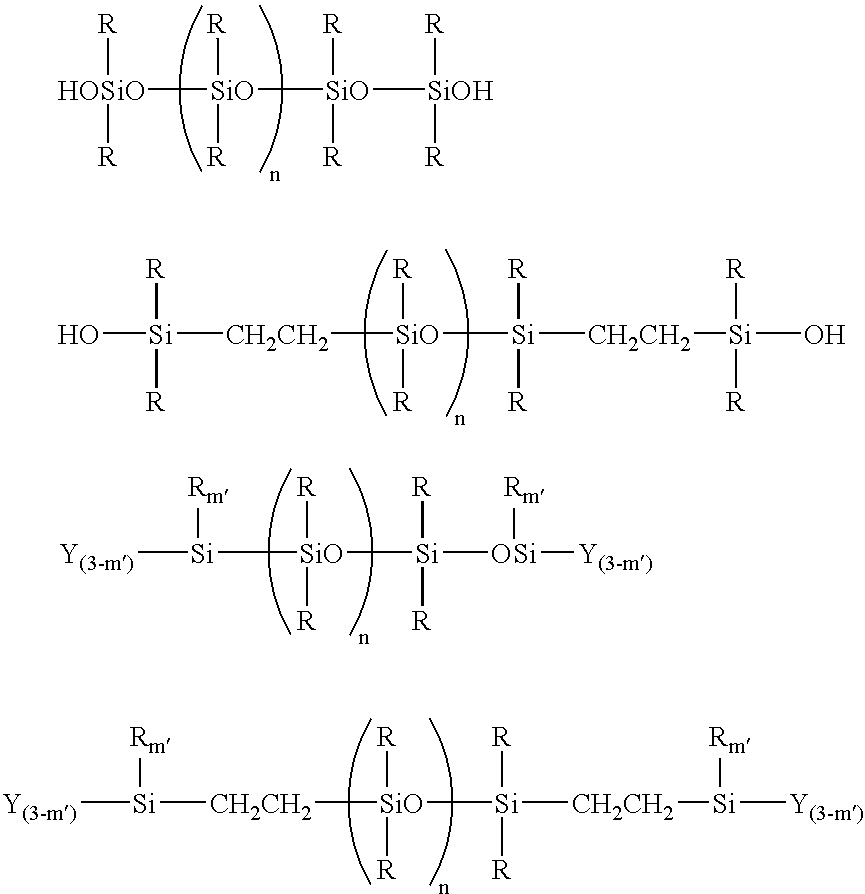Room-temperature curable organopolysiloxane composition
a technology of organopolysiloxane and composition, which is applied in the direction of antifouling/underwater paints, biocides, coatings, etc., can solve the problems of deterioration of adhesion, loss of esthetic appearance, and heavy soiled surface of cured sealing materials or coating materials, so as to prevent adhesion and growth, and superior long-term endurance of antifouling
- Summary
- Abstract
- Description
- Claims
- Application Information
AI Technical Summary
Benefits of technology
Problems solved by technology
Method used
Image
Examples
examples
[0053]As follows is a description of synthetic examples for the constituent (C) of the present invention, as well as a series of examples and comparative examples of the present invention. In each of the examples, the units “parts” refer to “parts by weight”, and the viscosity values refer to values measured at 25° C.
[Constituent (C) Synthetic Example 1]
[0054]In a flask were placed 500 g of toluene and 3,431 g of a polysiloxane represented by an average structural formula shown below:
(wherein, Me represents a methyl group. This abbreviation is also used in subsequent formulas),
and azeotropic water removal was performed under toluene reflux at 120° C. for 1 hour. Subsequently, the temperature was cooled to approximately 80° C., 2.5 g of a 2-ethylhexyl alcohol solution of chloroplatinic acid (concentration: 2% by weight) was added, and once a homogeneous solution had been obtained, 132.8 g of vinyldimethylchlorosilane was added gradually in a dropwise fashion to effect an addition re...
synthetic example 3 (
For Comparison)
[0056]In a flask were placed 500 g of toluene and 3,431 g of a polysiloxane represented by an average structural formula shown below:
and azeotropic water removal was performed under toluene reflux at 120° C. for 1 hour. Subsequently, the temperature was cooled to approximately 80° C., 2.5 g of a 2-ethylhexyl alcohol solution of chloroplatinic acid (concentration: 2% by weight) was added, and once a homogeneous solution had been obtained, 410 g of a polyoxyethylene represented by a formula CH2═CH—CH2(OC2H4)8OH, with a OH group at one terminal of the molecular chain and the other terminal blocked with an allyl group, was added gradually in a dropwise fashion to effect an addition reaction. Following completion of the dropwise addition, reaction was continued for 3 hours, and once it was confirmed that the silicon atom bonded hydrogen atoms had disappeared, the toluene was removed under reduced pressure at 100° C. and 10 mmHg. 3,650 g of a light yellow colored, transpar...
synthetic example 4 (
For Comparison)
[0057]In a flask were placed 100 g of toluene and 396 g (0.1 mol) of the compound obtained in the synthetic example 3, and azeotropic water removal was performed under toluene reflux at 120° C. for 1 hour. The temperature was then cooled to approximately 80° C. Subsequently, 30.4 g (0.2 mol) of tetramethoxysilane was added to the reaction system, a condensation reaction was conducted for 6 hours at 120° C., and the toluene was then removed under reduced pressure at 100° C. and 10 mmHg. A compound represented by an average structural formula shown below was obtained.
This compound is named compound D.
PUM
| Property | Measurement | Unit |
|---|---|---|
| temperature | aaaaa | aaaaa |
| pressure | aaaaa | aaaaa |
| temperature | aaaaa | aaaaa |
Abstract
Description
Claims
Application Information
 Login to View More
Login to View More - R&D
- Intellectual Property
- Life Sciences
- Materials
- Tech Scout
- Unparalleled Data Quality
- Higher Quality Content
- 60% Fewer Hallucinations
Browse by: Latest US Patents, China's latest patents, Technical Efficacy Thesaurus, Application Domain, Technology Topic, Popular Technical Reports.
© 2025 PatSnap. All rights reserved.Legal|Privacy policy|Modern Slavery Act Transparency Statement|Sitemap|About US| Contact US: help@patsnap.com



